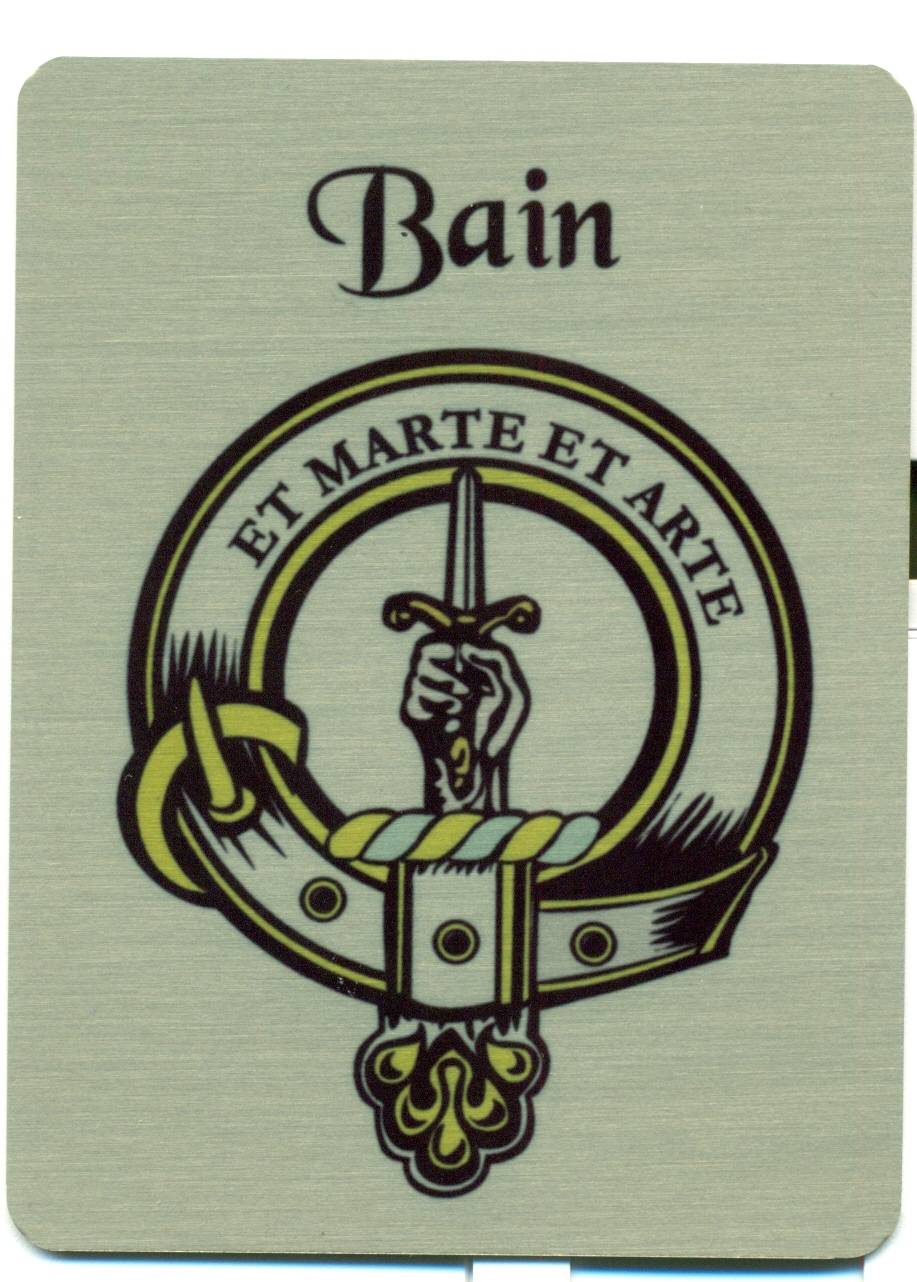From the Gaelic 'ban' - the fair. In 1324 Thomas Ban was a burgess in Perth. The Bains are descended from Neil, brother of Angus Dubh, Chief of the Mackay clan in the 15th Century.
THE FIRST BAIN
John Bain Mackay, son on Neil Neilson Mackay, was born 1408 in Strathnaver, Scotland,
and became the progenitor of the families Bane, Bene, Bain and Bayne by dropping his
real surname, Mackay, and using Bain as a surname.
After the battle of Drum-Nan-Coup, Angus Dubh Mackays were resentful over the
activities of Angus Moray of Cubin and their cousins, Morgan and Neil Mackay, whom he
had duped for the benefit of the bitter enemies, the Sutherlands.
The mother of John Bain Mackay had to be taken away from such unpleasant
conditions, so her son John took her to Olrig, in Caithness-shire in 1435, where they
received a friendly welcome due to the knowledge that their troubles had been inspired
by the Sutherland Clan. John married in 1436 and died in 1452, leaving issue - four
sons:
JOHN BAIN: born 1437, progenitor of the Bain families in Caithness and
Haddingtonshire.
WILLIAM BAIN: born 1438, progenitor of the Bain families of Clyth.
ALEXANDER BAIN: born 1440, progenitor of the Baynes of Tulloch and Dingwall.
DONALD BAIN: born 1443, settled in Galloway.
The descendants of John Bain Mackay are often referred to as the “Clan Bain” as there
are references to a Chief of the “Caithness Bains”.
William Bain, born 1494. Second son of John Bain, born 1437 and grandson of John
Bain Mackay, born 1408, had two sons, William II and Alexander I , who had a son
Duncan, who had a son Alexander II. He was “The Chief of the Caithness Bain Clan”
who was sent by the Earl of Caithness to witness the dismissal of the Earl of
Sutherlands’ army in 1601.
The spelling of the surname BAIN was first used with the birth of Donald Bain, born
1616, son of John Bane, born 1594. Prior to 1616, the surname was BANE, after 1616,
the surname used was spelled BAIN by all lines in Caithness, Clyth, Dochcarty,
Haddintonshire, Knochbain and Tarradale. The only group to differ was the small
groups in Tulloch in Ross-shire near Dingwall, who used BANE also until 1709, when
Kenneth Bane was made Burgess (Mayor) of Dingwall in 1709, changed the spelling to
BAYNE for the Tulloch group only. The Baynes of Tulloch are of the same lineage as all
Bains as their progenitor was Alexander Bane Mackay, born 1440 the third son of John
Bane Mackay, the progenitor of the Bain Clan. This will clarify any confusion caused by
spelling changes, which might suggest the Baynes of Tulloch are not of the same ilk.
From the very first, there was a tendency to separate and spread out. Many Bains
went to Thurso, Wick, Canisbay, Aberlour, Dingwall and Inverness. At all times they
strove to remain in the Highlands. This tendency was aggravated in the eighteenth and
nineteenth centuries by such conditions as overseas wars, the Sheep Clearances, the
deer forests required by the Lords, and emigration.
The Bain families as a whole have maintained a record of faithful, honourable and
distinguished service in many parts of the world, and in many spheres of activities.
They seemed to have excelled in many professional vocations, such as medicine,
business, teaching, ministry, promotion and founders of new towns in Canada and the
United States.
As a Sept of the Clan Mackay, the Bains use the Tartan, the motto and the “Strap and
Buckle” badge of the Clan Mackay.
Although the greatest concentration of Bains anywhere still remains in Caithness,
Scotland, there are probably some Bain groups wherever the English language is
spoken. Also, the children of the Gai’l, the Highlanders, bold and valient, whose
inherent love of freedom, courage and integrity, have contributed much to the strong
character of Canada, and other countries, where they emigrated to many years ago.




